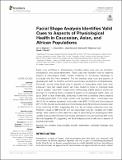Files in this item
Facial shape analysis identifies valid cues to aspects of physiological health in Caucasian, Asian and African populations
Item metadata
| dc.contributor.author | Stephen, Ian D. | |
| dc.contributor.author | Hiew, Vivien | |
| dc.contributor.author | Coetzee, Vinet | |
| dc.contributor.author | Tiddeman, Bernard | |
| dc.contributor.author | Perrett, David I. | |
| dc.date.accessioned | 2017-10-31T14:30:14Z | |
| dc.date.available | 2017-10-31T14:30:14Z | |
| dc.date.issued | 2017-10-30 | |
| dc.identifier | 251452446 | |
| dc.identifier | 63eb46c2-3930-4d0e-a1eb-6cc586625410 | |
| dc.identifier | 85032567521 | |
| dc.identifier | 000413891800001 | |
| dc.identifier.citation | Stephen , I D , Hiew , V , Coetzee , V , Tiddeman , B & Perrett , D I 2017 , ' Facial shape analysis identifies valid cues to aspects of physiological health in Caucasian, Asian and African populations ' , Frontiers in Neuroscience , vol. 8 , 1883 . https://doi.org/10.3389/fpsyg.2017.01883 | en |
| dc.identifier.issn | 1662-453X | |
| dc.identifier.other | ORCID: /0000-0002-6025-0939/work/64360975 | |
| dc.identifier.uri | https://hdl.handle.net/10023/11964 | |
| dc.description.abstract | Facial cues contribute to attractiveness, including shape cues such as symmetry, averageness and sexual dimorphism. These cues may represent cues to objective aspects of physiological health, thereby conferring an evolutionary advantage to individuals who find them attractive. The link between facial cues and aspects of physiological health is therefore central to evolutionary explanations of attractiveness. Previously, studies linking facial cues to aspects of physiological health have been infrequent, have had mixed results, and have tended to focus on individual facial cues in isolation. Geometric morphometric methodology (GMM) allows a bottom-up approach to identifying shape correlates of aspects of physiological health. Here, we apply GMM to facial shape data, producing models that successfully predict aspects of physiological health in 272 Asian, African and Caucasian faces – percentage body fat (21.0% of variance explained), body mass index (BMI; 31.9%) and blood pressure (BP; 21.3%). Models successfully predict percentage body fat and blood pressure even when controlling for BMI, suggesting that they are not simply measuring body size. Predicted values of BMI and BP, but not percentage body fat, correlate with health ratings. When asked to manipulate the shape of faces along the physiological health variable axes (as determined by the models), participants reduced predicted BMI, body fat and (marginally) BP, suggesting that facial shape provides a valid cue to aspects of physiological health. | |
| dc.format.extent | 1077174 | |
| dc.language.iso | eng | |
| dc.relation.ispartof | Frontiers in Neuroscience | en |
| dc.subject | Face perception | en |
| dc.subject | Health perception | en |
| dc.subject | Geometric morphometrics | en |
| dc.subject | Evolutionary psychology | en |
| dc.subject | Facial appearance | en |
| dc.subject | BF Psychology | en |
| dc.subject | NDAS | en |
| dc.subject.lcc | BF | en |
| dc.title | Facial shape analysis identifies valid cues to aspects of physiological health in Caucasian, Asian and African populations | en |
| dc.type | Journal article | en |
| dc.contributor.institution | University of St Andrews. School of Psychology and Neuroscience | en |
| dc.contributor.institution | University of St Andrews. Institute of Behavioural and Neural Sciences | en |
| dc.contributor.institution | University of St Andrews. Centre for Social Learning & Cognitive Evolution | en |
| dc.identifier.doi | 10.3389/fpsyg.2017.01883 | |
| dc.description.status | Peer reviewed | en |
| dc.identifier.url | https://www.frontiersin.org/articles/10.3389/fpsyg.2017.01883/full#h10 | en |
This item appears in the following Collection(s)
Items in the St Andrews Research Repository are protected by copyright, with all rights reserved, unless otherwise indicated.

